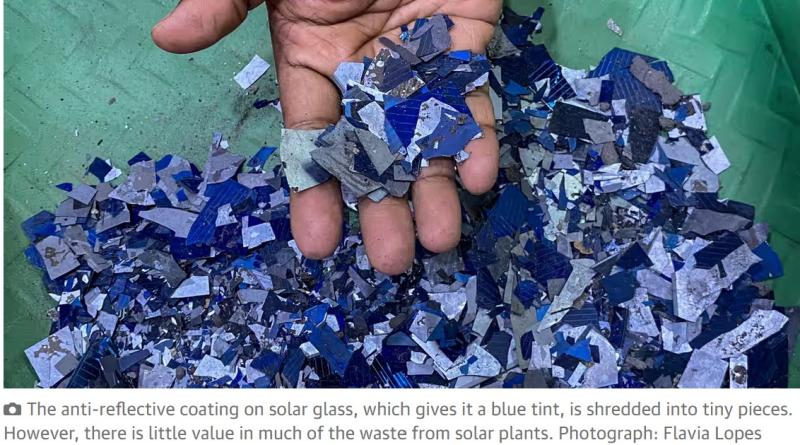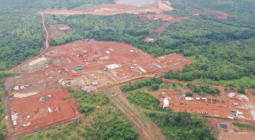Clean energy’s dirty secret: the trail of waste left by India’s solar power boom

Under the scorching sun, a sea of solar panels gleams in the semi-arid landscape. Pavagada, 100 miles north of Bengaluru in southern India, is the world’s third-largest solar power plant, with 25m panels across a huge 50 sq km site, and a capacity of 2,050MW of clean energy.
India has 11 similarly vast solar parks, and plans to install another 39 across 12 states by 2026, a commitment to a greener future.
Yet this solar boom has a downside: the waste it generates from the panels, made of glass, aluminium, silicon, rare-earth elements; as well as power inverters and wiring.
"These big recyclers, who claim that they deal in e-waste and solar waste, often offload their waste on to us Hussain
“While manufacturers claim decades of longevity, degradation of these panels sets in much sooner,” says Atif Mirza, director of Fusion Sprint Recycler, a solar-farm waste contractor in Uttar Pradesh. Panels can break during installation and transport or through exposure to monsoons and typhoons.
India’s solar ambitions come with a hefty amount of waste. With the nation targeting output of 280GW of solar power by 2030, of which 70.1GW is already installed, one study forecasts an accumulation of more than 600,000 tonnes of solar waste by then, with this projected to increase 32-fold to more than 19m tonnes by 2050.
About two-thirds of the waste is expected to originate from five states – Rajasthan, Gujarat, Karnataka, Tamil Nadu and Andhra Pradesh – which house eight of India’s 10 largest solar parks.
Naranaiah Amaranath, general manager at Karnataka Solar Power Development Corporation, which oversees the Pavagada solar park, acknowledges that while there are basic regulations regarding waste management, the responsibility largely falls on the private firms that own the solar plants.
Protocol dictates that solar waste from the plants must be transferred to e-waste contractors, authorised by the Central Pollution Control Board (CPCB), within a specified timeframe, typically 90 or 180 days.
However, practical and economic challenges abound. Site managers in Pavagada note that the selection of contractors is centralised, one company manages logistics for plants across India
“Most solar plants are located in remote areas, so the logistics and transportation is expensive, and once dismantled there is hardly any money from each individual part,” says Srinivas Vedula from EPragathi, a Bengaluru-based e-waste recycling company. “Plus, the solar glass has no value.”
Mirza, who is the official contractor for Ayana Renewable Power’s plants across India’s solar parks, including in Pavagada, says he sells dismantled parts to traders but admits: “We don’t know what they do with it.”
Because authorised e-waste contractors are often unwilling to handle the waste in accordance with the CPCB protocol, a network of informal operators – who dismantle, aggregate, transport and recycle panels – have stepped in to fill the gap.
Tayyab* and his family work at the tail end of this waste-management chain. In a dimly lit and poorly ventilated room in Bengaluru, the 20-year-old and his younger siblings spend their days dismantling broken panels for their valuable metals and other materials.
“I take apart the metal frame, separate the glass and sort out different metals that can be sold separately,” says Tayyab. There is no safety equipment in sight to prevent cuts from glass and sharp metals.
At a clandestine worksite in Goripalya, just outside Bengaluru, Tayyab skillfully manoeuvres through the hazardous process with bare hands and crude tools. His friend and siblings pitch in wherever they can.
Using a small three-wheeled auto-rickshaw, Tayyab’s friend Imran* makes the rounds of warehouses, collecting about 50 solar panels a week.
Tayyab’s story is just one among many in the informal solar-waste sector, where workers find ways to extract value from the under-regulated but booming renewable-energy sector.
Hussain* is from a family of e-waste dealers in household appliances, computers and televisions, but has carved out a niche for himself handling solar waste. He operates a factory on the outskirts of Bengaluru, described online as a solar manufacturer.
“There are few [people] who actually do this work,” says Hussain. “These big recyclers, who claim they deal in e-waste and solar waste, often offload their waste on to us.”
Despite lacking a licence, Hussain collects solar waste from plants across the country. “Sometimes they [plant managers] do not ask for any papers,” he says.
Hussain has more than 50 workers dismantling panels to sell the individual components to traders. “Silver is most valuable to us,” he adds.
India’s E-Waste Management Rules 2022, which came into force last April, require solar-panel manufacturers to oversee the return of their products’ waste by arranging collection, storage and dismantling, as well as the recycling facilities. They also need to store panel and cell waste up to 2035, according to CPCB guidelines.
Solar detritus was included for the first time in the 2022 e-waste rules but Rudresh Murthy, environmental officer at Karnataka State Pollution Control Board, admits: “There is still a lot to be done.”
“Economic viability remains a critical concern,” he says, citing the abrupt closure of a solar-waste recycling firm in Tamil Nadu in 2021 due to the economic downturn during the pandemic.
Murthy is unsurprised an informal solar-waste sector is thriving, claiming e-waste dealers often “don’t even properly manage e-waste, let alone solar waste”.
Srinivas says: “The government policy on solar waste is: let’s cross the bridge when we come to it.”
For people such as Tayyab, Imran and Hussain, the chance to make a living outweighs the risk of injuries. “We have gotten used to it,” says Tayyab.





